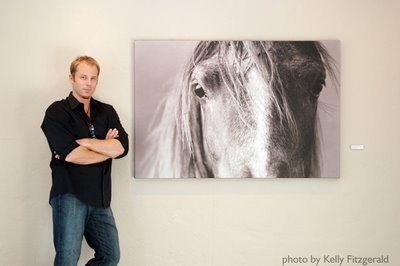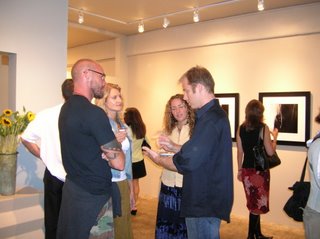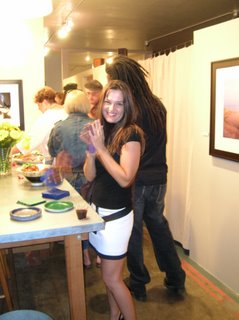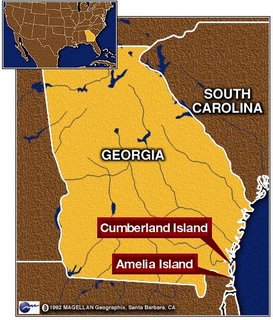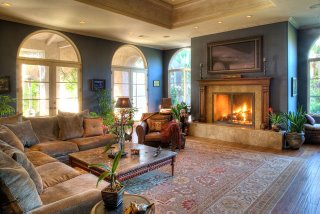
Cumberland Island, Georgia
Day 1 -- October 25, 2006
Laden down with a 90lb. backpack full of camera gear, and a 40lb. backpack full of camping gear, I hopped on the Cumberland Princess for the ferry ride from St. Mary's to Cumberland Island. The boat ride was relaxing, with beautiful views on all sides. We arrived on the island around 11am. I set up camp at the Sea Camp campsite and went for a walk to scout out the area and collect firewood. There were upwards of 50 people camping on the island, and another 50+ working and day-tripping, but the island was so spread out that during the 2 1/2 days I was there, I only saw about 20 different people wandering the island.
My scouting trip turned into a relatively long hike, but it was well worth the trek. It's only about a mile from Sea Camp to Dungeness (the ruins of the old Carnegie
 mansion), but there is plenty to see. The Dungeness ruins are essentially the remains of the Carnegie family estate, with the house proper and various parts of the property in a state of rapid decay. There are a few buildings that the Park Service has restored and kept up, but most of the grounds consist of not much more than crumbling walls, gates, steps and pathways. It really is an amazing estate, despite it's condition. It had to be... it was a self-sufficient residence on an island that, at the time, was not much more than wilderness.
mansion), but there is plenty to see. The Dungeness ruins are essentially the remains of the Carnegie family estate, with the house proper and various parts of the property in a state of rapid decay. There are a few buildings that the Park Service has restored and kept up, but most of the grounds consist of not much more than crumbling walls, gates, steps and pathways. It really is an amazing estate, despite it's condition. It had to be... it was a self-sufficient residence on an island that, at the time, was not much more than wilderness.There is a sandy road (the main entry road to Dungeness) that passes by the front of the home, past the recreation buildings and servants' quarters, and leads down to one of the most peaceful, expansive beaches on the east coast... White sand as fine as powder. Rolling dunes covered with a scattering of sea oats, and a big, beautiful ocean as far as the eye can see. After a long hike, and seeing the depressing condition of the old estate, this beach left me awestruck. It was so peaceful, so empty -- almost sad, but so refreshing, that I felt I could sit and gaze upon it all day.
Eventually, though, I broke myself away from the beach and headed back to camp. I took an alternate path along the boardwalk that ran alongside the saltwater marshes -- another different, but equally beautiful, landscape. When I got back to camp, I was beat. A little tuna, some rice, some trailmix for dessert, and I was ready for bed.
(In retrospect, I should have made the effort to shoot Dungeness at sundown. The sunset that evening was gorgeous. Foolishly, I assumed there would be more. Just one more lesson drilled into me the hard way: shoot it while you have the chance. You may never get another one.)
My plan was to gt up before sunrise, hike out to the estate, and capture Dungeness as the morning light bathed it in a dreamy and dramatic glow. I awoke at 6am, ate, then hiked with 70lbs of camera gear on my back to Dungeness in the pitch dark. My little flashlight lit the way for me, but it was still an eerie feeling walking through the wilderness with the sounds of nature scurrying about, knowing that at the end of your trail lies a decaying estate as deserving of ghosts as any place in the world.
It was a long hike with all that gear, and it was all for naught. The morning was overcast, and even sprinkled a little rain, and I never saw the sun. The light was very soft and definitely suitable for portraits and realism, but I was after a different effect -- I needed drama. And Mother Nature just wasn't going to give it to me that morning.
So, I hiked back disappointed (and tired). I dropped off my gear, grabbed my Nikon F5 and the big 400mm f/2.8 telephoto lens and set off to Sea Camp beach to find the resident wild horses.
 Dungeness was a disappointment, but the horses more than made up for it. They were feeding on the sea oats on the dunes and didn't give a tinker's damn about me. I was able to get within a few feet, just snapping away. They were pretty mellow, just walking and munching, walking and munching, and I got some great shots before they made their way back into the interior of the island. I'll try to catch up with them again tomorrow before I leave.
Dungeness was a disappointment, but the horses more than made up for it. They were feeding on the sea oats on the dunes and didn't give a tinker's damn about me. I was able to get within a few feet, just snapping away. They were pretty mellow, just walking and munching, walking and munching, and I got some great shots before they made their way back into the interior of the island. I'll try to catch up with them again tomorrow before I leave.My friend Brock, who works for the Cumberland Princess, rented me a bicycle and I rode back to Dungeness in the afternoon to try and grab a few shots of the estate during the day. (The ride is almost as tough as the hike. It's a sandy road, and the bike only has one gear. And with my pack, it felt as if I were pedaling with another person riding on my back).
 I photographed Dungeness in the direct afternoon sun with infrared film to try to take advantage of the unique properties of that film when used in bright sunlight. It really helped to convey the sense of lonliness and desperation that surrounded the grounds. One of the more photographed aspects of the estate is the Carnegie collection of family automobiles. Maybe "collection" is an inappropriate description. "Remanants" might be more accurate.
I photographed Dungeness in the direct afternoon sun with infrared film to try to take advantage of the unique properties of that film when used in bright sunlight. It really helped to convey the sense of lonliness and desperation that surrounded the grounds. One of the more photographed aspects of the estate is the Carnegie collection of family automobiles. Maybe "collection" is an inappropriate description. "Remanants" might be more accurate.That evening, I rode back to Dungeness to catch the sunset. And, yes, I packed out 70lbs of gear again. As the Boy Scouts say, "Be Prepared."
 Unfortunately, sundown was just like sunrise: Overcast. So, I walked down to the dunes a ways, took some images of a group of stark, warped trees working their way out of the sand, and shuffled on back to camp. A little dinner, a good night's rest, and I'd try again in the morning.
Unfortunately, sundown was just like sunrise: Overcast. So, I walked down to the dunes a ways, took some images of a group of stark, warped trees working their way out of the sand, and shuffled on back to camp. A little dinner, a good night's rest, and I'd try again in the morning.The next morning saw a very light sprinkling of rain (which comes with the requisite overcast skies), so I opted to sleep in a little, forego Dungeness, and try to catch up with the horses on the beach. After breaking camp at 9am and hauling my gear up to the ranger's station to await the 4:30pm ferry, I grabbed my F5 and the 400 f/2.8 and went out in search of the horses. They were nowhere to be found. So, I grabbed the rest of my cameras and lenses, hopped on
 the bike, and rode back to Dungeness. I spent a little time shooting the old family cars which lie along the path that leads to the beach. The cars, which include what looked like Model A Fords, Studebakers, and Packards were in various states of decay. Fifteen years ago, these cars were somewhat intact. 15 years from now, they will likely be dust. Such is the fate of so much of America's history.
the bike, and rode back to Dungeness. I spent a little time shooting the old family cars which lie along the path that leads to the beach. The cars, which include what looked like Model A Fords, Studebakers, and Packards were in various states of decay. Fifteen years ago, these cars were somewhat intact. 15 years from now, they will likely be dust. Such is the fate of so much of America's history.Leaving valuable property at camp or at the ranger's station isn't much of a concern when there are so few people on the island and the only way on or off the island is by boat. So, I stowed my gear at the station and went down to the beach for a little sun and relaxation.
By mid-afternoon, I still hadn't seen the horses, so I went back to the ranger's station to sit in a rocking chair by the water and wait on the ferry to take me back to the mainland. At the station, I struck up a conversation with another couple, Jim and Dorrell Antley, who said they saw the horses meandering down by the cottages at the boat dock near Dungeness. Dorrell offered to take me over there in her dinghy so I wouldn't have to hike the whole way and miss my ferry. (Aren't Southerners so gracious? Who else would be that considerate?)
 Dorrell dropped me off at the dock and, sure enough, the horses were having a little snack on the grass near the cottages. But what
Dorrell dropped me off at the dock and, sure enough, the horses were having a little snack on the grass near the cottages. But what really caught my attention was the 4 or 5 horses munching away down in the marshes. So, I hoofed it through the woods and tracked the horses through the marshes as they ate. (Seems all these animals do is eat.)
really caught my attention was the 4 or 5 horses munching away down in the marshes. So, I hoofed it through the woods and tracked the horses through the marshes as they ate. (Seems all these animals do is eat.)I hiked back through the woods to the station, coming across a few more horses along the way, and hopped on the ferry back to St. Mary's. From there I would drive to Amelia Island (Fernandina Beach), hook up with my friend Marcus for the Georgia/Florida football game, and then drive back to Atlanta.
 I had a blast with the gang at the game. We all stayed in a fantastic bed and breakfast on second street called The Addison (www.addisononamelia.com). It was run by a lively, generous, wonderful woman named Karol Kirby, who essentially took care of us for the two days we stayed with her. I highly recommend staying with Karol at the Addison. It truly puts you in touch with what's going on in historic Amelia Island.
I had a blast with the gang at the game. We all stayed in a fantastic bed and breakfast on second street called The Addison (www.addisononamelia.com). It was run by a lively, generous, wonderful woman named Karol Kirby, who essentially took care of us for the two days we stayed with her. I highly recommend staying with Karol at the Addison. It truly puts you in touch with what's going on in historic Amelia Island.













